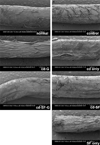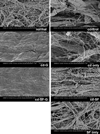Application of carbodiimide derivatized synovial fluid to enhance extrasynovial tendon gliding ability
- PMID: 21371626
- PMCID: PMC3625936
- DOI: 10.1016/j.jhsa.2010.12.015
Application of carbodiimide derivatized synovial fluid to enhance extrasynovial tendon gliding ability
Abstract
Purpose: To investigate the effects of surface modification of extrasynovial tendon with a carbodiimide derivatized synovial fluid (SF) on the gliding ability of extrasynovial tendon for a possible tendon graft application.
Methods: We used 63 peroneus longus tendons from canine hind legs. We immediately assessed 3 tendons morphologically using a scanning electron microscope (SEM); these served as the normal tendon group. The other 60 tendons were randomly assigned to each of 6 experimental groups treated with (1) control (saline); (2) 1% 1-ethyl-3-(3-dimethylaminopropyl) carbodiimide hydrochloride (EDC) plus 1% N-hydroxysuccinimide (NHS) (cd only); (3) 1% EDC/NHS plus 10% gelatin (cd-G); (4) SF plus 1% EDC/NHS plus 10% gelatin (cd-SF-G); (5) SF only; or (6) SF plus 1% EDC/NHS (cd-SF). We measured the gliding resistance for 1,000 cycles of simulated flexion-extension motion. We also observed the tendon surface smoothness by SEM.
Results: Compared with the first cycle in each group, the gliding resistance after 1,000 cycles of tendon motion was significantly increased in the control, cd only, cd-gelatin, SF only, and cd-SF groups (p<.05). In contrast, we found no significant difference in gliding resistance between the first cycle and 1,000 cycles for the cd-SF-G-treated group. In addition, the gliding resistance in the cd-SF, cd-G, and cd-SF-G groups was significantly lower than the control group after 1,000 cycles of tendon motion (p<.05) and the gliding resistance of the cd-SF-G group was significantly lower than both the cd-G and cd-SF groups (p<.05). On SEM, the surface treated with cd-SF-G was smooth after 1,000 cycles, whereas the other surfaces were rough.
Conclusions: Surface modification of extrasynovial tendon with cd-SF-G improves tendon gliding ability. This treatment may be useful clinically in improving the outcomes of tendon autografts.
Copyright © 2011 American Society for Surgery of the Hand. All rights reserved.
Figures






Similar articles
-
Lubricin surface modification improves extrasynovial tendon gliding in a canine model in vitro.J Bone Joint Surg Am. 2008 Jan;90(1):129-35. doi: 10.2106/JBJS.G.00045. J Bone Joint Surg Am. 2008. PMID: 18171967
-
Optimization of surface modifications of extrasynovial tendon to improve its gliding ability in a canine model in vitro.J Orthop Res. 2006 Jul;24(7):1555-61. doi: 10.1002/jor.20205. J Orthop Res. 2006. PMID: 16732611
-
Surface treatment of flexor tendon autografts with carbodiimide-derivatized hyaluronic Acid. An in vivo canine model.J Bone Joint Surg Am. 2006 Oct;88(10):2181-91. doi: 10.2106/JBJS.E.00871. J Bone Joint Surg Am. 2006. PMID: 17015595 Free PMC article.
-
Effect of curing time and concentration for a chemical treatment that improves surface gliding for extrasynovial tendon grafts in vitro.J Biomed Mater Res A. 2006 Dec 1;79(3):451-5. doi: 10.1002/jbm.a.30868. J Biomed Mater Res A. 2006. PMID: 16752399 Free PMC article.
-
Indigo-A New Tribological Substance Class for Non-Toxic and Ecological Gliding Surfaces on Ice, Snow, and Water.Materials (Basel). 2022 Jan 24;15(3):883. doi: 10.3390/ma15030883. Materials (Basel). 2022. PMID: 35160831 Free PMC article. Review.
Cited by
-
Surface Modification with Chemically Modified Synovial Fluid for Flexor Tendon Reconstruction in a Canine Model in Vivo.J Bone Joint Surg Am. 2015 Jun 17;97(12):972-8. doi: 10.2106/JBJS.N.01100. J Bone Joint Surg Am. 2015. PMID: 26085530 Free PMC article.
-
Carbodiimide-Derivatized Synovial Fluid for Tendon Graft Coating Improves Long-Term Functional Outcomes of Flexor Tendon Reconstruction.Plast Reconstr Surg. 2023 Nov 1;152(5):840e-849e. doi: 10.1097/PRS.0000000000010390. Epub 2023 Mar 14. Plast Reconstr Surg. 2023. PMID: 36912937 Free PMC article.
-
Biomechanical evaluation of flexor tendon graft with different repair techniques and graft surface modification.J Orthop Res. 2015 May;33(5):731-7. doi: 10.1002/jor.22844. Epub 2015 Mar 2. J Orthop Res. 2015. PMID: 25665071 Free PMC article.
-
Investigation and optimization of formulation parameters on preparation of targeted anti-CD205 tailored PLGA nanoparticles.Int J Nanomedicine. 2015 Dec 10;10:7371-84. doi: 10.2147/IJN.S90866. eCollection 2015. Int J Nanomedicine. 2015. PMID: 26677326 Free PMC article.
-
Targeted Therapeutic Nanoparticles: An Immense Promise to Fight against Cancer.J Drug Deliv. 2017;2017:9090325. doi: 10.1155/2017/9090325. Epub 2017 Dec 31. J Drug Deliv. 2017. PMID: 29464123 Free PMC article. Review.
References
-
- Kleinert HE, Schepel S, Gill T. Flexor tendon injuries. Surg Clin North Am. 1981;61:267–286. - PubMed
-
- Lister GD, Kleinert HE, Kutz JE, Atasoy E. Primary flexor tendon repair followed by immediate controlled mobilization. J Hand Surg. 1977;2:441–451. - PubMed
-
- Chow JA, Thomes LJ, Dovelle S, Milnor WH, Seyfer AE, Smith AC. A combined regimen of controlled motion following flexor tendon repair in “no man’s land”. Plast Reconstr Surg. 1987;79:447–455. - PubMed
-
- Small JO, Brennen MD, Colville J. Early active mobilisation following flexor tendon repair in zone 2. J Hand Surg. 1989;14B:383–391. - PubMed
-
- Amadio PC, Wood MB, Cooney WP, 3rd, Bogard SD. Staged flexor tendon reconstruction in the fingers and hand. J Hand Surg. 1988;13A:559–562. - PubMed
MeSH terms
Substances
Grants and funding
LinkOut - more resources
Full Text Sources

